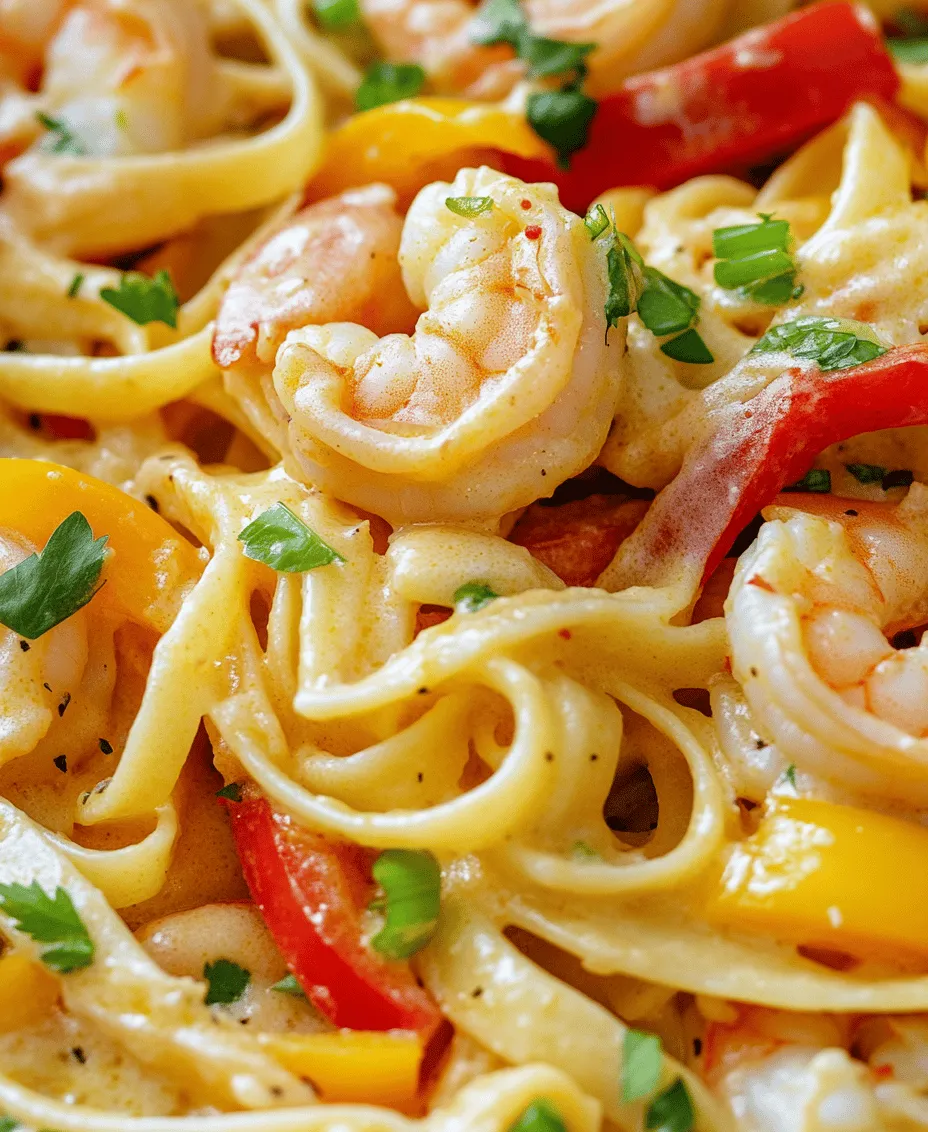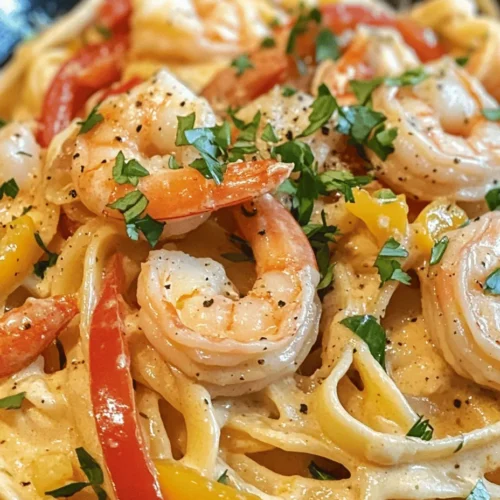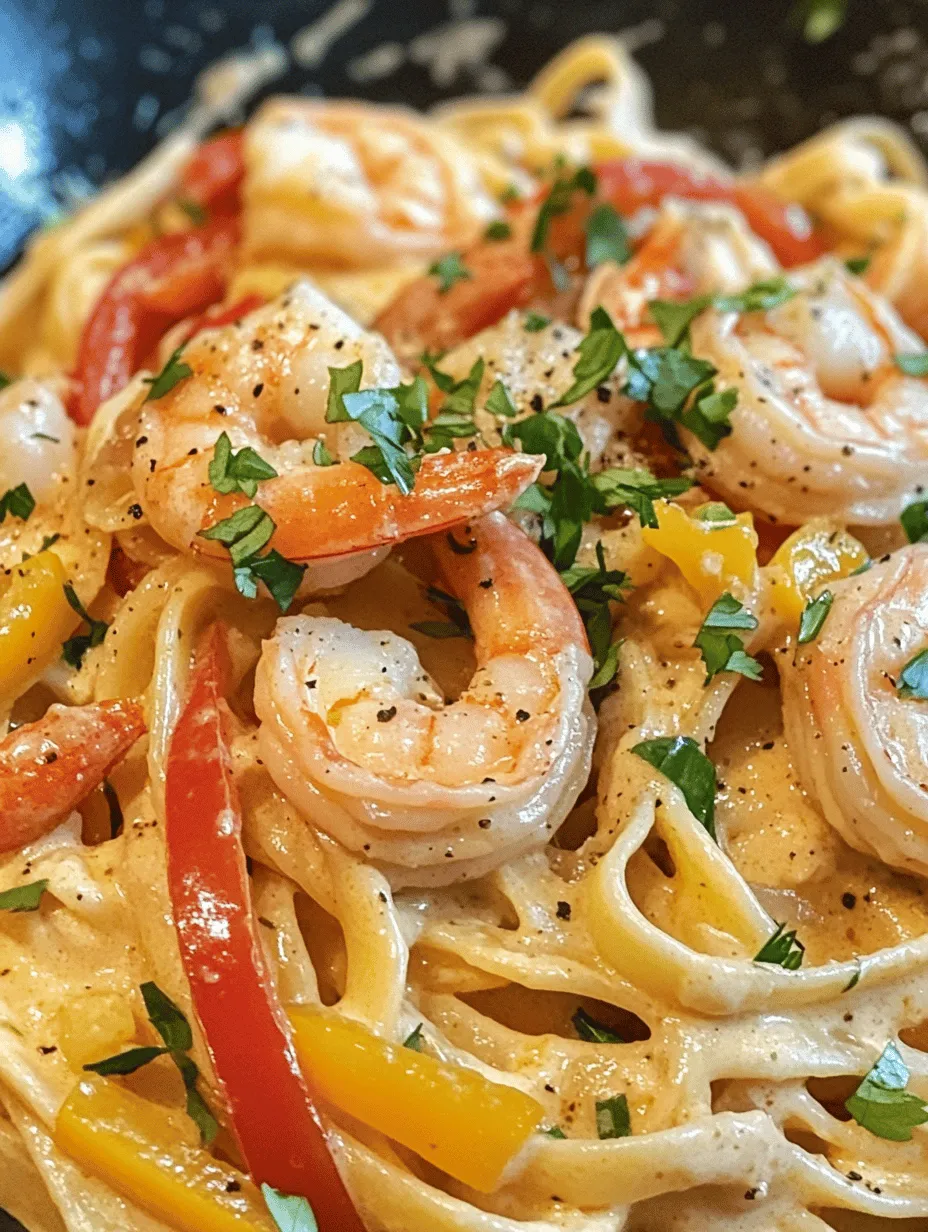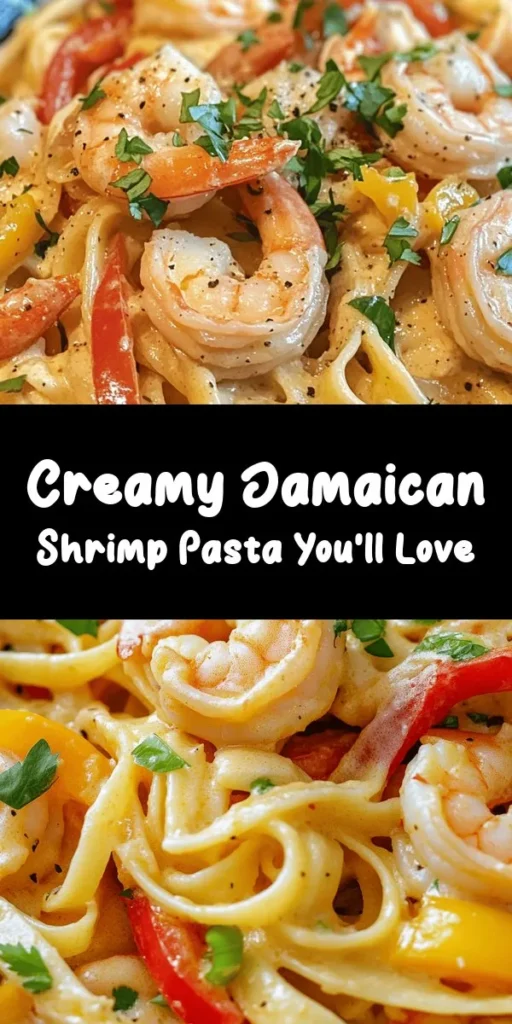Introduction
Jamaican cuisine is a vibrant tapestry woven from the rich cultural influences of the island’s history. It is a celebration of bold flavors, aromatic spices, and fresh ingredients that come together to create dishes that are as colorful as they are delicious. Among these culinary treasures is the Jamaican Shrimp Pasta, a dish that showcases the best of both Jamaican and Italian influences, offering a unique fusion that tantalizes the taste buds.
Jamaican Shrimp Pasta is not just a meal; it’s a delightful experience that brings together the sweetness of shrimp, the creaminess of a rich sauce, and the warmth of traditional Jamaican spices. This dish is particularly appealing because of its creamy texture, which is enhanced by the combination of coconut milk and heavy cream, resulting in a sauce that perfectly clings to the pasta. The addition of fresh vegetables adds not only color but also a crunch that complements the softness of the shrimp, making it a well-rounded dish.
One of the standout features of Jamaican Shrimp Pasta is its simplicity. With a cooking time of approximately 30 minutes, this dish is perfect for weeknight dinners when you want something delicious yet quick. Alternatively, it can be dressed up for special occasions, making it a versatile option for any gathering. From family dinners to festive celebrations, Jamaican Shrimp Pasta is sure to impress with its rich flavors and enticing aroma.
Exploring the Flavor Profile of Jamaican Shrimp Pasta
At the heart of Jamaican Shrimp Pasta lies a careful selection of ingredients that work harmoniously to create a symphony of flavors. The key components of this dish are not only essential for taste but also play a significant role in defining its unique character.
Key Ingredients and Their Roles
The pasta serves as the foundation of this dish, acting as a canvas for the vibrant sauce and the succulent shrimp. Linguine or fettuccine is often preferred due to their ability to hold onto the creamy sauce, ensuring that every bite is bursting with flavor.
Now, let’s talk about the star of the show: the shrimp. Large, juicy shrimp are essential for this recipe, providing a sweet seafood flavor that pairs beautifully with the creamy sauce. When sourcing shrimp, it’s best to choose fresh or high-quality frozen shrimp to achieve the best results. Properly preparing the shrimp, such as deveining and cleaning them, ensures that they are not only tasty but also visually appealing in the final dish.
The sauce is where the magic truly happens. Coconut milk and heavy cream are combined to create a luxuriously creamy texture that envelops the shrimp and pasta. Coconut milk adds a subtle sweetness and a hint of tropical flavor, while heavy cream enriches the sauce, making it decadent and satisfying. This combination not only enhances the dish’s flavor but also contributes to its creamy visual appeal.
Spices play a pivotal role in defining the essence of Jamaican cuisine and are integral to the flavor profile of Jamaican Shrimp Pasta. Allspice, paprika, and cayenne pepper are often used to add warmth and depth. Allspice brings a complex flavor that hints at cinnamon, nutmeg, and cloves, while paprika adds a mild sweetness and a vibrant red color to the dish. A touch of cayenne pepper introduces a gentle heat, ensuring that the dish is not only rich but also flavorful.
Fresh vegetables are essential for both texture and color. Bell peppers, onions, and garlic are commonly used, each contributing its own unique flavor. Bell peppers offer a sweet crunch, onions provide a savory base, and garlic adds an aromatic punch that elevates the entire dish. Together, these ingredients create a balanced meal that is as beautiful as it is delicious.
Ingredient Breakdown
To prepare the perfect Jamaican Shrimp Pasta, it’s vital to understand each ingredient’s role and how they come together to create this savory dish. Let’s delve deeper into the specifics of the ingredients used.
Linguine or Fettuccine Pasta
Choosing the right pasta is crucial for the success of this dish. Linguine and fettuccine are preferred choices because their flat shapes allow for maximum sauce adherence. When cooked to al dente perfection, they provide the ideal texture, creating a satisfying bite that complements the creaminess of the sauce.
Large Shrimp
When it comes to shrimp, size matters. Large shrimp, preferably wild-caught, are ideal for this recipe due to their juicy texture and natural sweetness. When purchasing shrimp, look for ones that are firm to the touch and have a fresh briny scent. For preparation, ensure they are deveined and shelled, allowing them to absorb the flavors of the dish while cooking.
Coconut Milk and Heavy Cream
The creaminess factor of Jamaican Shrimp Pasta comes from the combination of coconut milk and heavy cream. Coconut milk adds a rich, tropical flavor that is synonymous with Caribbean cuisine, while heavy cream enhances the sauce’s texture, making it velvety and indulgent. Nutritionally, coconut milk provides healthy fats, while heavy cream contributes to the overall richness. This balance creates a sauce that is both satisfying and flavorful.
Fresh Vegetables
Incorporating fresh vegetables is essential not only for flavor but also for visual appeal. Bell peppers bring a sweet crunch and vibrant color, while onions add a savory depth to the sauce. Garlic, known for its aromatic qualities, enhances the overall flavor profile. Using fresh vegetables ensures that the dish is not only delicious but also packed with nutrients, making it a wholesome meal option.
Spices
The significance of spices in Jamaican cuisine cannot be overstated. Allspice, often referred to as “pimento,” adds a warm, aromatic flavor that is a hallmark of Jamaican cooking. Paprika contributes a mild sweetness and color, while cayenne pepper provides a gentle heat that can be adjusted according to personal preference. These spices work together to create a depth of flavor that is both comforting and exciting.
Cooking Method
Now that we have a clear understanding of the ingredients, let’s move on to the cooking method. Preparing Jamaican Shrimp Pasta is a straightforward process that involves several key steps to ensure that each component is cooked to perfection.
Step-by-Step Process
1. Cook the Pasta: Begin by bringing a large pot of salted water to a boil. Add the linguine or fettuccine and cook according to the package instructions until al dente. The pasta should have a slight bite to it, as it will continue to cook when combined with the sauce later. Once cooked, drain the pasta, reserving a cup of the pasta water for later use. This starchy water can help to adjust the sauce’s consistency if needed.
2. Sauté the Vegetables: In a large skillet, heat a drizzle of oil over medium heat. Add diced onions and sauté until they become translucent. Next, add minced garlic and diced bell peppers, cooking until they begin to soften. This step builds the flavor base of the dish, ensuring that the vegetables are tender yet crisp.
3. Prepare the Shrimp: Once the vegetables are ready, add the cleaned shrimp to the skillet. Season with salt, pepper, allspice, paprika, and cayenne pepper to taste. Cook the shrimp until they turn pink and are cooked through, which usually takes about 3-5 minutes. Be careful not to overcook the shrimp, as they can become tough.
4. Create the Sauce: After the shrimp are cooked, pour in the coconut milk and heavy cream, stirring to combine. Allow the sauce to simmer for a few minutes, letting the flavors meld together. If the sauce is too thick, add a splash of the reserved pasta water until you achieve the desired consistency.
5. Combine Pasta and Sauce: Finally, add the cooked pasta to the skillet, tossing it in the creamy sauce until well coated. Allow the pasta to heat through for a couple of minutes, ensuring every strand is enveloped in the rich sauce. This is the moment when the dish truly comes together, creating a beautiful marriage of flavors and textures.
By following these steps, you will create a dish that is not only visually appealing but also bursting with flavor. The combination of the creamy sauce, succulent shrimp, and fresh vegetables makes Jamaican Shrimp Pasta a standout meal that is sure to impress.
—
In the next part of this article, we will explore additional tips for achieving the best results with your Jamaican Shrimp Pasta, as well as address some common questions about this delightful dish. Stay tuned for more insights into making this creamy delight a centerpiece at your dining table.

Sautéing Vegetables: Techniques for Enhancing Flavor
To create a robust flavor base for your Jamaican Shrimp Pasta, it’s essential to master the art of sautéing vegetables. Begin by heating a generous splash of olive oil in a large skillet over medium-high heat. The oil should shimmer but not smoke, signaling that it’s hot enough to work its magic. Adding your vegetables—such as bell peppers, onions, and scallions—at this stage allows them to caramelize slightly, enhancing their natural sweetness and adding depth to the dish.
A key technique is to avoid overcrowding the pan. If your skillet is too full, the vegetables will steam rather than sauté, resulting in soggy texture instead of the desired crisp-tender feel. Stir frequently to ensure even cooking, allowing the vegetables to soften and become fragrant. This stage is crucial; it sets the foundation for the complex flavors that will unfold in the final dish.
Adding Aromatics: The Impact of Garlic and Ginger
Garlic and ginger are indispensable to Jamaican Shrimp Pasta, providing aromatic depth that elevates the dish to new heights. Once your vegetables have softened, it’s time to introduce these flavor powerhouses. Mince or finely chop about three cloves of garlic and a one-inch piece of ginger, adding them to the pan. Stir continuously for about 30 seconds, or until you can smell their tantalizing aroma wafting through your kitchen.
The key here is to sauté them just enough to release their oils and flavors without allowing them to burn, which can introduce bitterness. This aromatic mixture creates a fragrant base that permeates the pasta and shrimp, marrying the ingredients beautifully. Garlic offers a rich, savory note, while ginger imparts a warm, zesty kick that reflects the vibrant Caribbean influence in this dish.
Cooking Shrimp: Tips for Achieving Perfectly Cooked Shrimp
Perfectly cooked shrimp are the star of the show in this recipe. To ensure they maintain their tender, juicy texture, start with fresh or properly thawed shrimp. If you’re using frozen shrimp, ensure they are fully thawed and patted dry to remove excess moisture. This step is crucial to achieving that perfect sear.
Add the shrimp to the skillet after the aromatics have been incorporated. Cook them for about 2-3 minutes on each side, until they turn pink and opaque. Be cautious not to overcook the shrimp, as they can quickly become rubbery. An excellent indicator is the “C” shape they form when cooked perfectly—the tighter the curl, the more overcooked they are. Remove the shrimp from the skillet once they are done, allowing them to rest while you prepare the sauce.
Making the Sauce: Balancing Flavors and Achieving the Desired Consistency
The sauce for Jamaican Shrimp Pasta is where the magic truly happens. In the same skillet, after removing the shrimp, add a splash of chicken or vegetable broth, along with a generous dose of coconut milk. This creamy base embodies the essence of Caribbean cooking, providing a luscious texture that complements the shrimp and pasta beautifully.
To balance the flavors, add a tablespoon of soy sauce for umami, a squeeze of lime juice for acidity, and a sprinkle of cayenne pepper for a subtle kick. Allow the sauce to simmer gently, thickening and merging the flavors for about 5-7 minutes. You want a creamy consistency that can coat the pasta without being too runny. If the sauce becomes too thick, a splash of pasta water can help loosen it up, while also enhancing its flavor with the starch from the pasta.
Combining Pasta and Sauce: Best Practices for Ensuring Even Coating
Once your pasta is cooked al dente (usually about 8-10 minutes in boiling salted water), it’s time to bring everything together. Reserve a cup of pasta cooking water before draining, as it can be invaluable for adjusting the sauce’s consistency.
Toss the drained pasta directly into the skillet with the sauce, stirring gently to coat every strand evenly. If the sauce appears too thick, add reserved pasta water a little at a time until you achieve your desired consistency. Gently fold in the cooked shrimp, allowing the heat to warm them through without further cooking.
Nutritional Information
Jamaican Shrimp Pasta is not only delicious but also packed with nutritional benefits. A standard serving typically contains approximately 450-500 calories, depending on portion sizes and specific ingredients used. This dish provides a well-rounded profile of macro and micronutrients.
Macronutrients
– Protein: Shrimp is an excellent source of lean protein, essential for muscle growth and repair.
– Carbohydrates: The pasta contributes complex carbohydrates, providing energy and aiding in digestive health.
– Fats: Healthy fats from coconut milk contribute to overall nutrition while enhancing flavor.
Micronutrients
– Vitamins and Minerals: Shrimp is rich in selenium, vitamin B12, and iodine, while the vegetables add vitamins A and C, along with dietary fiber.
Health Benefits
Incorporating shrimp and a variety of vegetables into your diet can contribute to heart health, improved cognitive function, and better digestion. To make this dish even healthier, consider using whole wheat or gluten-free pasta options, and increase the quantity of vegetables for added nutrients and fiber.
Serving Suggestions and Pairings
To elevate your Jamaican Shrimp Pasta experience, consider pairing it with complementary side dishes and beverages. Here are some suggestions:
Side Dishes
– Fresh Garden Salad: A simple green salad dressed with a light vinaigrette can balance the richness of the pasta.
– Grilled Vegetables: Seasonal grilled vegetables, such as zucchini, asparagus, or bell peppers, can enhance the meal’s vibrancy.
– Jamaican Rice and Peas: This classic dish can add a traditional element to your meal, rounding out the flavors beautifully.
Beverage Pairings
– White Wine: A crisp Sauvignon Blanc or a light Pinot Grigio pairs wonderfully with the flavors of the shrimp and coconut milk.
– Rum Punch: For a tropical twist, serve a refreshing rum punch that complements the Caribbean essence of the dish.
Presentation Tips
To create an enticing presentation, serve the pasta in shallow bowls, garnishing with freshly chopped cilantro or parsley for a pop of color. A wedge of lime on the side not only adds visual appeal but invites diners to enhance their flavor experience.
Cultural Significance of the Dish
The roots of shrimp in Jamaican cuisine run deep, reflecting the island’s rich maritime history. Shrimp has been a staple in Caribbean diets for centuries, often used in various traditional dishes that celebrate the region’s bountiful seafood.
This recipe is a perfect example of how Jamaican culinary traditions blend with Italian influences, showcasing the adaptability of pasta in Caribbean cooking. Pasta, a staple in Italian cuisine, has found its place on many Jamaican tables, illustrating the fusion of cultures and flavors that characterize the island’s culinary landscape.
Conclusion
Jamaican Shrimp Pasta is a delightful dish that combines the best of both Caribbean and Italian flavors, creating a meal that is not only delicious but also versatile. Whether you’re hosting a dinner party or simply enjoying a family meal, this recipe offers a unique twist that will leave your taste buds dancing.
Encouraging you to try this recipe will also open the door to exploring more Caribbean flavors, enriching your culinary repertoire. Cooking is a joyful experience meant to be shared with loved ones, and this dish is sure to become a favorite in your home. So gather your ingredients, follow the steps, and enjoy the pleasure of creating and sharing a meal that celebrates the vibrant flavors of Jamaica.



